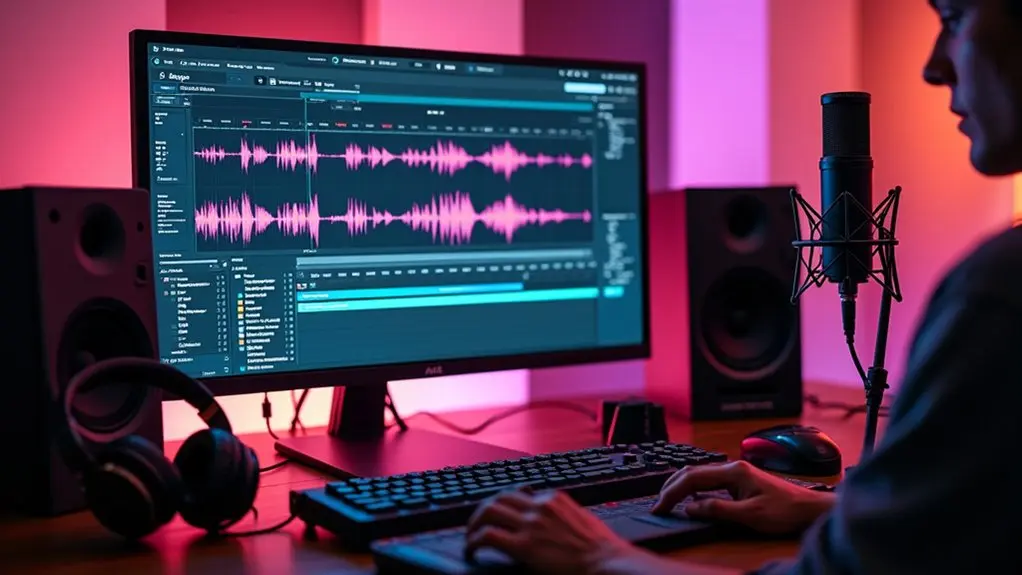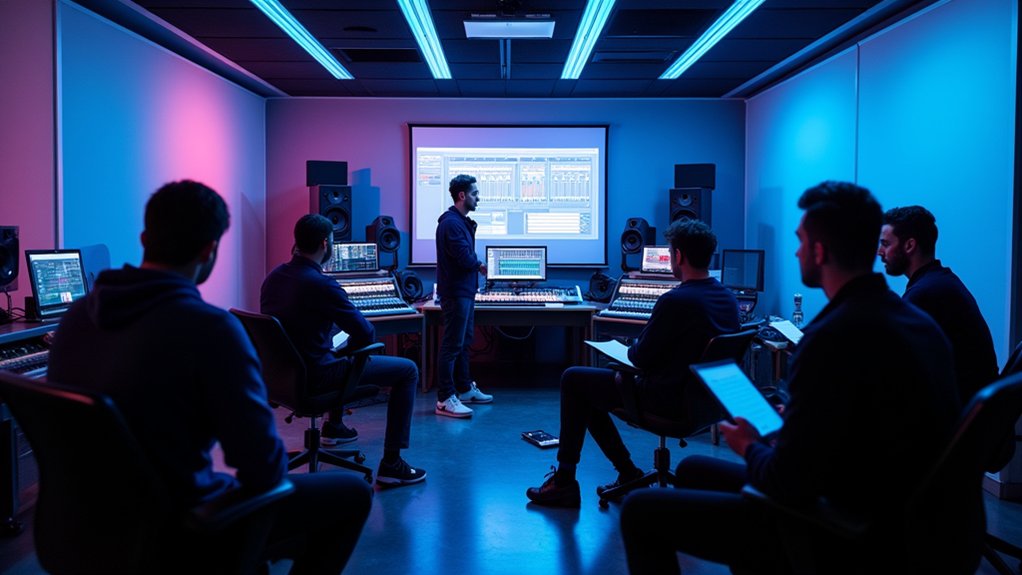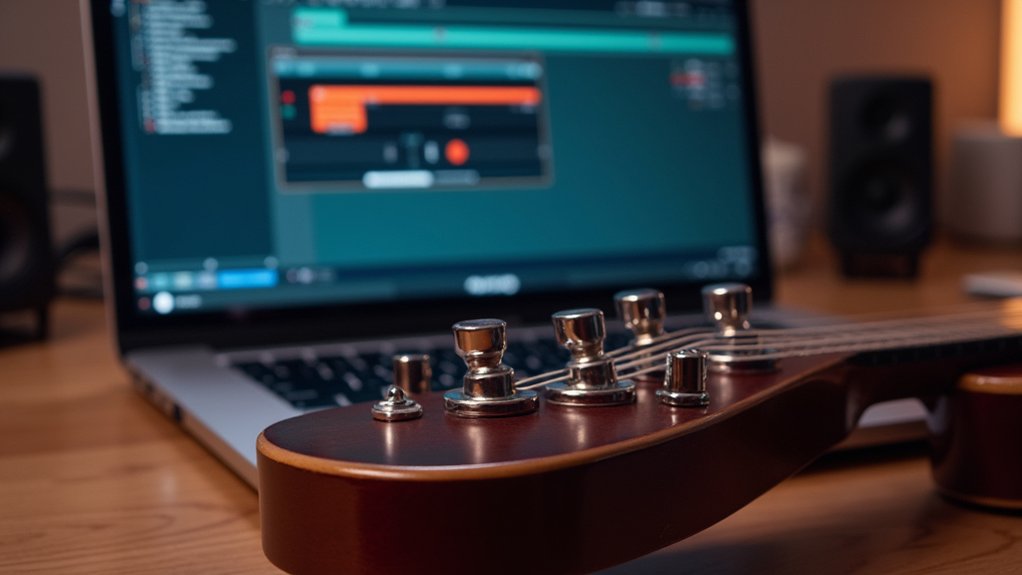Ableton Live Lite is ideal for beginners or those on a budget, providing 8 tracks, basic effects, and a 2 GB sound library—often for free with hardware. Live Intro, priced at $99, expands the toolkit with 16 tracks, 26 effects, and a 5 GB library, suiting producers seeking greater creative flexibility and more advanced compositions. For users weighing track count, tools, and workflow, understanding the specific limitations and strengths of each version can clarify the choice further.
Key Takeaways
- Live Lite is free with select hardware and ideal for beginners needing basic music production tools and limited tracks.
- Live Intro offers double the track count, more instruments, and a larger sound library for more complex projects.
- Intro includes advanced effects and better hardware integration, supporting more sophisticated workflows and creative flexibility.
- Budget-conscious users can start with Lite, but Intro is better suited for expanding creative needs and more demanding production.
- Upgrading from Lite to Intro is easy, letting users scale up as their skills and project complexity grow.
Key Differences Between Ableton Live Lite and Intro
Although both Ableton Live Lite and Intro serve as entry points into digital music production, significant distinctions exist in their track limits, built-in audio effects, sound library size, and editing capabilities.
The primary differences between Ableton Live Lite and Intro revolve around the number of audio and MIDI tracks each version supports, the quantity of built-in effects, and the breadth of the sound library.
Live Lite, as a more basic production software, offers fewer tracks and effects, with a smaller sound library suited for beginners.
In contrast, Live Intro expands on these features, allowing for more creative flexibility and advanced editing options.
These enhancements make Intro more appealing for users aiming to pursue professional-level projects, highlighting a clear progression within the Ableton Live product range. The simplified interface of Live Lite facilitates quick music creation, making it ideal for beginners looking to develop foundational skills before advancing to more complex versions.
Track Limits, Instruments, and Effects Compared
When evaluating Ableton Live Lite and Intro, clear distinctions emerge in track limits, instrument availability, and included effects.
For those considering music production capabilities, these differences directly impact creative possibilities and project complexity.
- Track Limits: Live Lite restricts users to 8 audio and MIDI tracks, while Intro extends this capacity to 16. This increase allows for more layered arrangements and complex audio sessions.
- Instruments and Library: Intro offers 15 software instruments and a 5 GB sound library, compared to Lite’s modest selection and 2 GB of sounds. This gives Intro users greater flexibility and variety for music creation.
- Effects: Lite includes 21 built-in effects, but Intro expands to 26, adding advanced tools like Auto Pan and Looper, enhancing audio processing options.
- Real-time performance capabilities in Ableton Live make it more suitable for complex live electronic music setups, offering features like Session View for live clip manipulation.
Workflow and Hardware Integration
Steering through the workflow differences between Ableton Live Lite and Intro reveals critical distinctions in project complexity and hardware integration.
Live Lite, with its eight-track limit, encourages users to optimize workflow by creatively utilizing racks—combining instruments and MIDI effects on individual tracks. This streamlined approach suits beginners or those working on simpler projects.
In contrast, Live Intro doubles the track count, affording greater flexibility for intricate arrangements and layered compositions. Hardware integration is significantly more advanced in Live Intro, providing seamless connectivity with external instruments and effects, which enables users to expand their creative setup without elaborate configuration.
Additionally, Live Intro supports enhanced MIDI automation and clip editing, facilitating a more sophisticated workflow for those seeking deeper control over arrangement and production elements. Mastering Ableton Live Basics can further enhance efficiency and creativity in music production, ensuring users make the most of either version’s capabilities.
Pricing, Availability, and How to Get Live Lite
While both Ableton Live Lite and Live Intro share the same retail price of $99, Live Lite is frequently distributed at no cost through partnerships with hardware manufacturers and software bundles.
This distinct approach to pricing and availability makes Live Lite particularly accessible for newcomers. Users can often acquire Ableton Live Lite when purchasing select MIDI controllers, audio interfaces, or other music production hardware.
In contrast, Live Intro’s purchase is more straightforward, as it is sold directly via Ableton and authorized retailers.
Examining Live Lite vs Intro regarding acquisition:
- Live Lite is bundled with various MIDI controllers and music hardware.
- Occasional software promotions offer Live Lite free with eligible purchases.
- Both versions can be bought directly at the official $99 price point.
Getting Creative With Limitations in Live Lite
Many producers find that the inherent limitations of Ableton Live Lite—such as the maximum allowance of eight audio and MIDI tracks—serve as catalysts for inventive workflow strategies. These constraints require users to approach production with heightened intentionality, often leading to a focus on arrangement and sound selection. By utilizing racks, multiple instruments and effects can be combined within a single track, optimizing the available resources. Supplementing Lite’s built-in instruments with free plugins further broadens creative possibilities, allowing for continued experimentation despite the limited track count. Additionally, the use of the included core library, as well as external sample sources, fosters resourcefulness in sound design. Leveraging powerful plugins like Valhalla Supermassive and others can enhance the soundscape possibilities within Ableton Live Lite, providing users with rich reverbs and delays to create expansive auditory experiences. Ultimately, these limitations encourage creativity and skill development, as producers must maximize every element within Lite’s environment.
Which Version Suits Your Music Production Needs?
Selecting between Ableton Live Lite and Intro depends on an assessment of their respective feature sets, workflow implications, and financial considerations. Users must weigh the expanded track count, sound library, and advanced editing capabilities in Intro against the streamlined, entry-level approach of Lite. Evaluating upgrade options and long-term production goals can further clarify which version aligns best with individual needs. For those starting out, Live Lite provides an accessible entry point into music production, allowing the creation and editing of music tracks with up to 8 audio and MIDI tracks per project.
Feature Set Comparison
Although both Ableton Live Lite and Intro serve as entry points into the Ableton ecosystem, their feature sets differ markedly, shaping the scope of music production possible with each version.
The main difference lies in the scale and diversity of tools available. Live Lite comes with a restriction of 8 audio and MIDI tracks, while Intro increases this to 16, allowing for more complex arrangements.
In a feature set comparison, Intro’s expanded library of over 5 GB of sounds and virtual instruments surpasses Live Lite’s 2 GB, offering greater creative resources.
Additionally, Intro introduces advanced audio effects and modulation devices absent in Live Lite.
- Track Limit: Lite (8), Intro (16)
- Built-in Content: Lite (2 GB), Intro (5+ GB)
- Additional Effects: Intro provides advanced audio effects and modulation tools
Workflow and Usability
Beyond feature sets, workflow and usability are pivotal in determining which Ableton version aligns with a user’s production style.
Ableton Live Lite offers a streamlined interface, favoring beginners who prioritize simplicity and foundational functionality. Its limitation to 8 audio and MIDI tracks constrains workflow efficiency for larger projects, but may suffice for basic arrangements.
Conversely, Live Intro expands this limit to 16 tracks, accommodating more complex compositions and multi-layered arrangements. Intro’s advanced features, including enhanced audio and MIDI clip editing, automation, and control mappings, further bolster workflow efficiency.
Both versions provide access to the Session View, facilitating flexible arrangement and live performance. However, Live Intro’s superior hardware integration and broader toolset deliver a more seamless and professional user experience for demanding production environments.
Budget and Upgrade Paths
For cost-conscious producers evaluating Ableton’s entry-level offerings, Live Lite and Live Intro present distinct value propositions aligned with varying production ambitions.
Live Lite is a budget-friendly option, often bundled at no additional cost with select hardware and software, making it accessible for beginners who require essential features.
Live Intro, priced at $99, appeals to users seeking additional track capacity and a more thorough sound library.
Upgrade paths are straightforward, allowing users to shift from Lite to Intro as their creative needs evolve.
While both versions share core samples and loops, their differences may impact workflow and project complexity.
- Live Lite: Free with select products; limited to 8 tracks and a smaller sound library.
- Live Intro: $99; offers 16 tracks and expanded features.
- Upgrade Paths: Simple shift supports evolving production requirements.
Frequently Asked Questions
What Is the Difference Between Ableton Live Lite and Full Edition?
Ableton features comparison reveals full edition offers unlimited tracks, advanced devices, and extensive editing, while Lite functionality limits workflow. Intro advantages overview and pricing structure analysis show user experience feedback heavily favors full version for serious production needs.
Should I Get Ableton Live Intro or Standard?
When evaluating whether to choose Ableton Live Intro or Standard, one should consider Intro features comparison, pricing differences, user experience, software limitations, and music production goals, as Standard provides broader capabilities while Intro caters to simpler needs and budgets.
What Are the Drawbacks of Ableton Live Lite?
Ableton Live Lite’s drawbacks include limited features such as a restricted track count of eight, fewer MIDI effects, and reduced audio clips capacity. Export options are also constrained, making it less suitable for complex or professional production workflows.
Is Ableton Live Lite or Intro Better?
The comparison highlights that Lite features limited tracks and instruments, while Intro limitations are fewer, offering expanded capabilities. User experience favors Intro for complex music production, though pricing comparison shows Lite as more accessible for beginners seeking essential tools.
Conclusion
Ultimately, Ableton Live Lite and Intro cater to distinct user needs. Live Lite serves as an accessible entry point, ideal for beginners or those seeking basic project capabilities, often bundled with hardware. Intro, while still limited, expands creative potential with more tracks, instruments, and effects. The decision hinges on production requirements, budget, and desired flexibility. Careful consideration of each version’s specifications guarantees users select the most suitable option for their workflow and musical ambitions.




